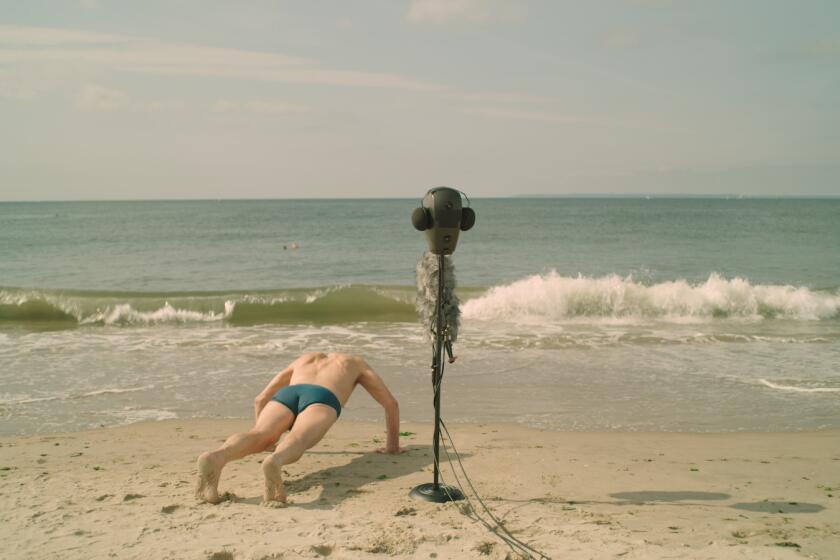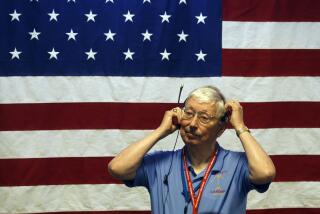Review: Space exploration documentary ‘It’s Quieter in the Twilight’ is sometimes too quiet

- Share via
The space exploration documentary “It’s Quieter in the Twilight” has some of the right stuff. But for the average viewer, it may prove as slow-going as the last decade or so in the waning mission the film spotlights: the more than 45-year-old NASA-funded Voyager program.
First, a little history. In 1977, twin robotic spacecraft named Voyager 1 and Voyager 2 were launched to fly near the four outermost planets — Jupiter, Saturn, Uranus and Neptune — to gather valuable data and transmit it back to Earth. A reported 1,200 people initially worked on the captivating project, though in more recent years, as the probes entered interstellar space traveling beyond the solar system, only a dozen staffers have remained to manage and monitor the mission’s imminent end.
These deeply dedicated souls, who have postponed retirement to guide these famed if largely forgotten spacecraft through their “twilight” years, are the focus of director Billy Miossi’s meditative, alternatively arcane and awe-inspiring look at NASA’s longest-running mission.
The enduring Voyager team profiled here includes project manager Suzy Dodd; engineers Enrique Medina, Fernando Peralta, Sun Kang Matsumoto and Todd Barber; missions operations manager Jefferson Hall; technical consultant Chris Jones (he left the mission in 2021); and project scientist Ed Stone, who retired last year at 86 after a half-century of service. They receive their close-ups as they work out of a nondescript office park in Altadena, Calif., which proves a less-than-thrilling background for much of the film. A move to NASA’s nearby Jet Propulsion Laboratory later occurs following the start of the COVID-19 pandemic.
Filmmaker Sam Green’s film questions what we see and feel when we hear and shows us why listening more deeply can make life more worthwhile.
Unfortunately, while the intellect of Voyager’s passionate staff is impressive, they’re not always the most scintillating bunch; their often highly technical discussions can make for some dry viewing. In addition, these folks’ eclectic histories, which Miossi presents via one-on-one interviews and personal archival visuals, although enlightening in a how-did-they-get-here sense (Medina, Peralta and Matsumoto grew up in, respectively, Mexico, Colombia and South Korea), can feel a bit pro forma. There are several more emotional moments, though, that bring us closer to our subjects.
The doc, shot from 2019 to 2021, is more successful when it reminds us of the dazzling scope of the Voyager mission, especially in its early days when it fed the public’s appetite for real-life outer space adventure in the biggest way since the 1969 moon landing.
Voyager-generated photos of such spectacular sights as the rings of Saturn and the volcanoes on Io (a moon of Jupiter) are a vivid inclusion as well.
It’s also cool to contemplate some of the more astonishing facts and figures that are peppered in here. Not the least of these is that the Voyagers have flown as far as a record 14 billion miles from Earth. That’s billion with a B. Or, if you prefer, they are now three times farther from the sun than our former ninth planet, Pluto.
Miossi also attempts to add some ticking-clock action to the proceedings as he tracks several downturns in the spacecraft’s power and capacity to effectively transmit data. At one point, the team must rescue Voyager 2 from potential demise when a power glitch shuts down its instruments. That commands are sent to control the compromised probe using mid-1970s technology adds to the movie’s low-key tension.
Further complicating matters, there can be a lag time of 16 to 20 hours for the spacecraft’s signals to reach Earth. Plus, only one majestic antenna dish, located in Canberra, Australia, can interface with the Voyagers, which are solely visible from Earth’s Southern Hemisphere — and that satellite is shutting down for maintenance. As the film makes clear, it’s miraculous that this NASA enterprise is still operational.
To that end, the Voyager team hopes the ailing spacecraft can survive until 2027 so they can celebrate the mission’s 50th anniversary. For now, though, they have this earnest, reflective film to mark their life’s work and help keep Voyager alive in the mind of its older — and maybe now newer — fans.
'It’s Quieter in the Twilight'
Not rated
Running time: 1 hour, 24 minutes
Playing: Starts May 19, Laemmle NoHo 7, North Hollywood; also on VOD
More to Read
Only good movies
Get the Indie Focus newsletter, Mark Olsen's weekly guide to the world of cinema.
You may occasionally receive promotional content from the Los Angeles Times.











